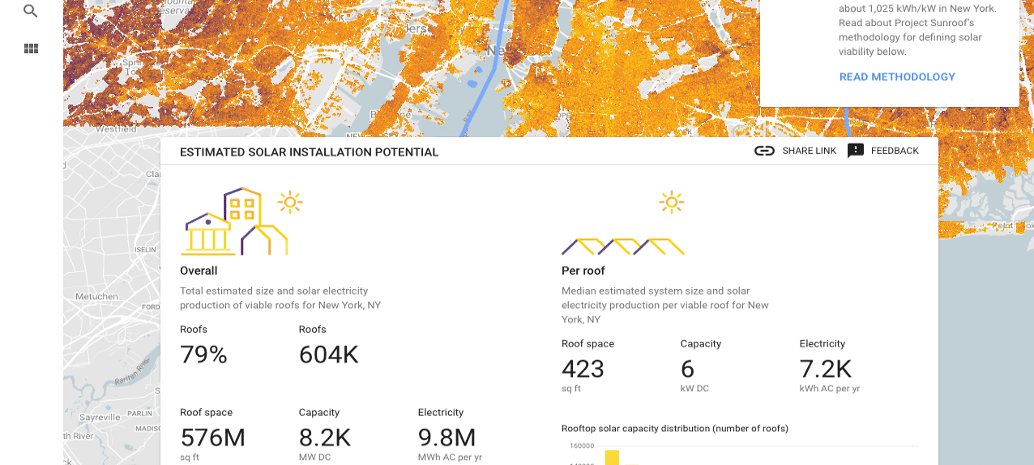Google made big waves last year when it announced Project Sunroof, an online mapping and analysis tool for potential solar customers, which provided free information on the solar potential of a given roof as well as financial and incentive analyses.
When originally launched, project Sunroof looked only at the Boston metro area, San Francisco and Fresno, California. Since that time the tech giant has expanded the tool to metro areas in 42 states, for a total of 43 million homes.
Last week the product expanded further, with Project Sunroof offering not only estimates for individual buildings, but the combined technical potential of entire zip codes and cities, using 3D rooftop geometry from Google Earth.
This phrase – technical potential – is key to understanding what the community-level data explorer tool does and does not do. Importantly, technical capacity is not the same as the current capacity of roofs under existing laws and codes.
Perhaps the strongest example here is New York City. Project Sunroof gives the Big Apple 604,000 “viable” roofs, or 79% of all roofs, a total solar potential of 8.2 GW. However, in New York City the fire code requires a six-foot setback on flat-roof buildings. This has made many flat-roofed buildings – which Project Sunroof relies on for the large majority of the 8.2 GW – not viable. (Editor’s note: this issue was explored in detail in pv magazine’s July print edition).
A page on the methodology behind Project Sunroof acknowledges this issue, noting that “the current version of the placement algorithm does not explicitly include setbacks from the roof edge.” Also, many of the roofs which add to this capacity may be technically viable but not ideal for an individual property owner. Many of the city-wide estimates include a portion of north-facing roofs, and while more are listed in Southern cities like New Orleans these are not ideal conditions anywhere in the continental United States.
Given these limitations, city-wide estimates by Project Sunroof and similar mapping tools may help to capture the public imagination, but are misleading for casual viewers who may not know about the practical issues that would prevent cities from approaching their technical potential.
This content is protected by copyright and may not be reused. If you want to cooperate with us and would like to reuse some of our content, please contact: editors@pv-magazine.com.









By submitting this form you agree to pv magazine using your data for the purposes of publishing your comment.
Your personal data will only be disclosed or otherwise transmitted to third parties for the purposes of spam filtering or if this is necessary for technical maintenance of the website. Any other transfer to third parties will not take place unless this is justified on the basis of applicable data protection regulations or if pv magazine is legally obliged to do so.
You may revoke this consent at any time with effect for the future, in which case your personal data will be deleted immediately. Otherwise, your data will be deleted if pv magazine has processed your request or the purpose of data storage is fulfilled.
Further information on data privacy can be found in our Data Protection Policy.